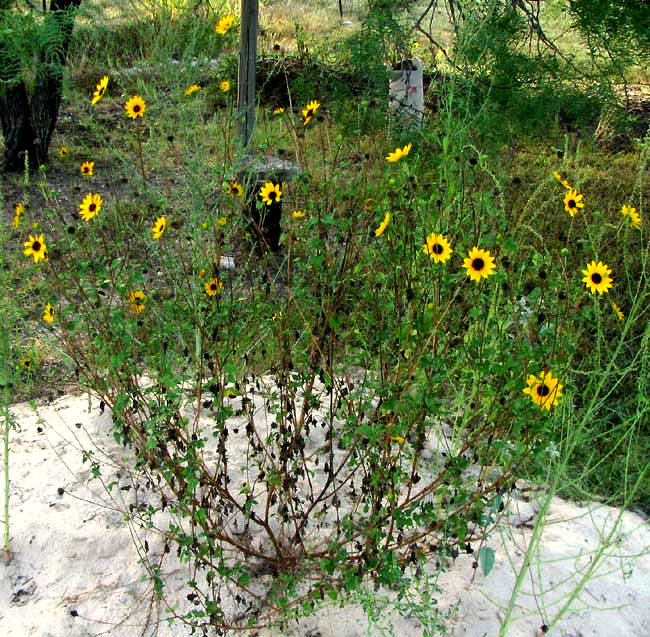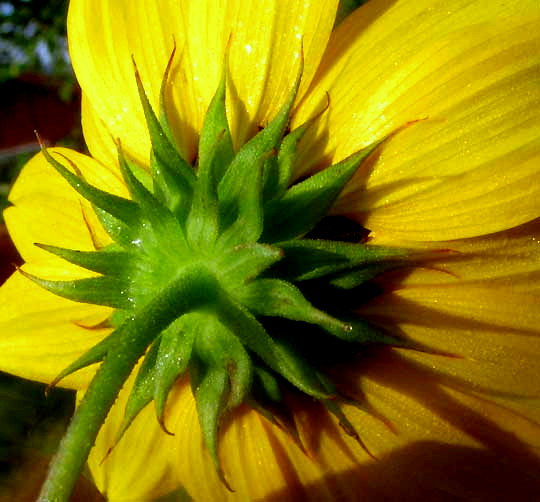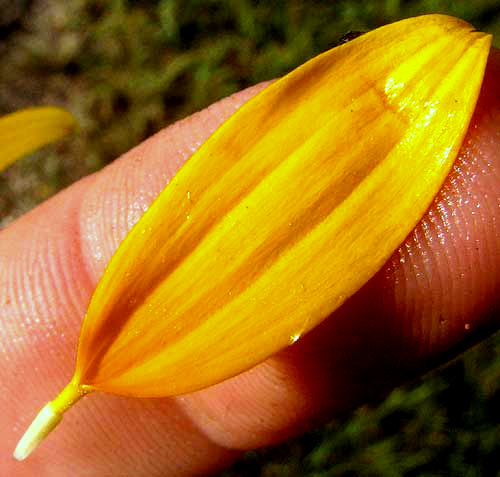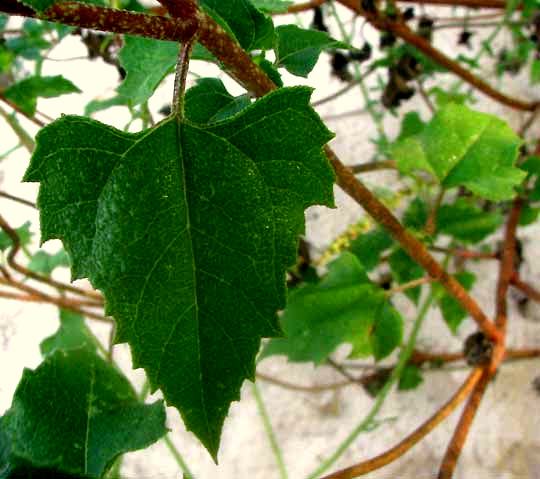Excerpts from Jim Conrad's
Naturalist Newsletter

from the September 22, 2013 Newsletter issued from the Frio Canyon Nature Education Center in the valley of the Dry Frio River in northern Uvalde County, southwestern Texas, on the southern border of the Edwards Plateau; elevation ~1750m (~5750 ft); N29.62°, W99.86°; USA
SAND SUNFLOWER
Last fall at the red cabin in the valley where I lived last winter a truck delivered a load of sand for building purposes and for use in loosening up our clayey garden soil. This spring a few plants germinated and took hold, which was surprising because of the dry, sterile condition of the sand. How could any herbaceous plant survive on a heap of sand during this summer's drought? The plants not only survived but thrived. I couldn't imagine what species they might be, so I began waiting for flowers. One of the much-branched plants standing five feet high (1.5m), is shown above.
Obviously it's a member of the Composite or Sunflower Family, even looking like a real sunflower, genus Helianthus. However, there are lots of sunflower-like genera, and Helianthus itself is home to about 52 species, all North American, so this week it was time to "do the botany."
The green involucre below the flowering head is composed of triangular, sharp-pointed bracts, or phyllaries that overlap like house shingles, which is typical of Helianthus species, as shown below:

The flowering heads are composed of dark reddish disc flowers forming the head's dark eye, while yellow ray flowers do the attention-getting service performed by petals in most flowers, as shown below:

With those large style branches curling out of the dark disc flowers, it's clear that the disc flowers are fertile and thus produce cypsela-type fruits, which we call "seeds" when thinking about sunflower seeds. However, if you pull off a ray flower you see that it has no style branches, and the thing at the base that would mature into a fruit is tiny, as if it's not turning into anything. Below, you can see a "neuter" non-fruit-producing ray flower without style branches atop the non-functioning ovary:

All this is also exactly right for the sunflower genus Helianthus -- fertile disc flowers but infertile ray flowers. Furthermore, breaking open a head you see that the base of each disc flower is partially enveloped by a papery bract, or "palea," that's purplish and three-toothed at its top, which is very typical for sunflowers.
Finally, this plant's leaves are more or less triangular, saw-toothed margined (serrate), rough-textured on top and alternate, all perfectly permissible for sunflowers, as shown below:

With all these features we're sure we have a sunflower. The following features help us figure out which sunflower it is:
The plant arises from a taproot, which I could feel by poking a finger down through the sand at its base/ there's one leaf per stem node (leaves are alternate); the disk corollas are dark reddish instead of yellow as in many species; the paleae are deeply three-toothed, and; leaves are triangular with large, evenly spaced teeth, or serrations, along their margins.
Our plant is HELIANTHUS DEBILIS, variously known as the Sand Sunflower, Beach Sunflower, Dune Sunflower, Weak Sunflower and Cucumberleaf Sunflower.
Sand Sunflower is native to the US Southeast's Coastal Plain area but has been turning up wherever it's sandy along the eastern seaboard as far north a Maine, as well as in numerous countries across the world such as South Africa, Australia, Taiwan, Slovakia, and Cuba. We're on the extreme western margin of its natural distribution area and I'm not sure if it's native here or not. I doubt it, since normally we don't have much sand here. I'm guessing that our sand was brought to Uvalde County by train or truck, probably beaches in the Houston area.
Sand Sunflower is so attractive and able to thrive in fairly sterile sand that it's sold for xeriscaping purposes. Several cultivars have been developed, including 'Italian White,' 'Flora Sun,' 'Dazzler,' 'Excelsior,' and 'Orion.'
Small seed-eating birds eat the sunflower-seed-like fruits.